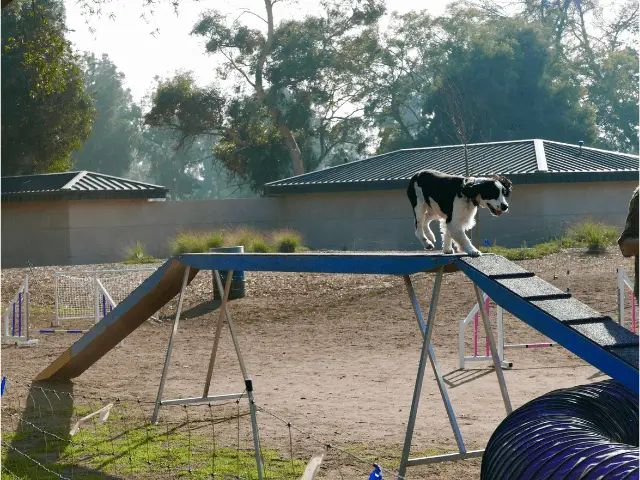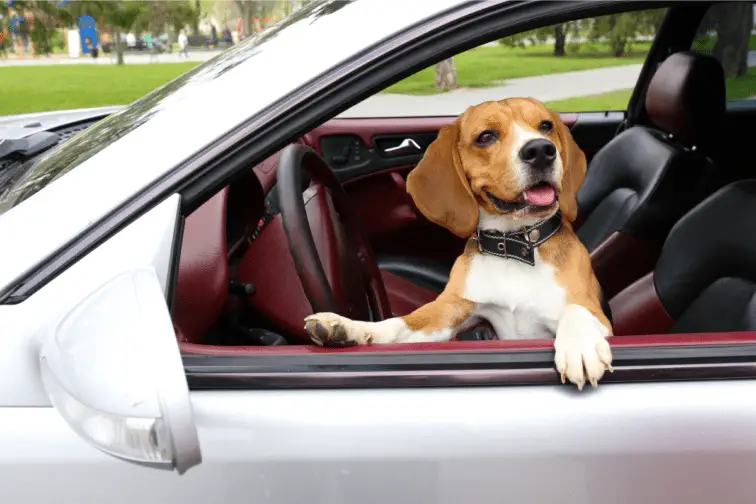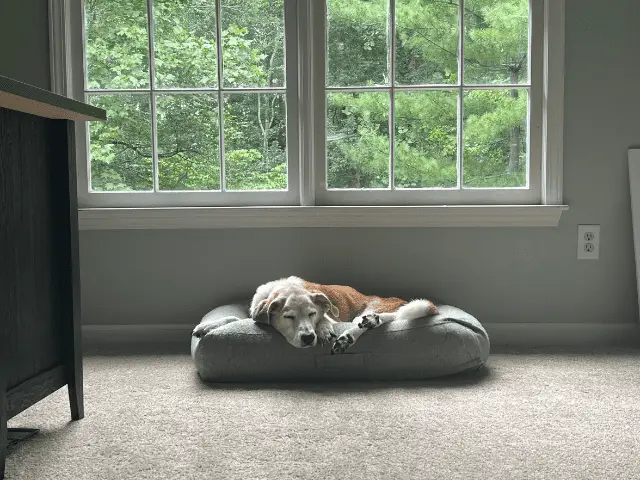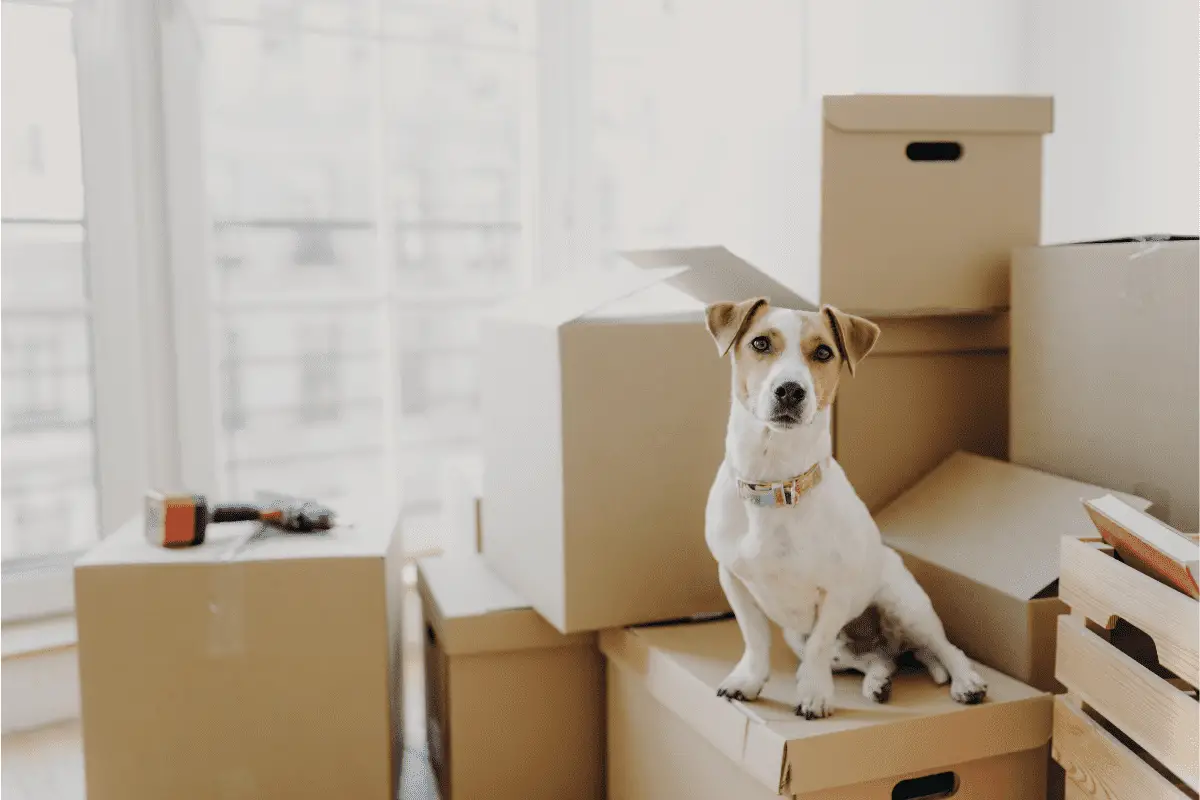It takes about three weeks for most dogs to settle and feel safe in an unfamiliar home. But you’re there to give them the attention and comfort they need. And they have their “cratey” or spot under a bed when they crave the security of an enclosed space.
But if you stay close while helping your dog explore the new home, they’re sure to go it alone when ready—even though it takes more time for some dogs than others.
Our dogs, Chompers and Mia, have quite a few moves under their belt (Our 17-year-old Chompers has lived in a dozen different homes!). Keep reading to learn some tried-and-true strategies for making a dog feel comfortable in a new home.
Table of Contents
Prepare Your Dog for the Move Well in Advance
A few weeks before moving day, start desensitizing your dog to the presence of moving supplies and new activities in the midst by subtly placing moving-related items in what will eventually become an active work area.
Be incredibly gentle if your dog suffers from separation anxiety .
.
Try to create a positive feeling by offering treats if they approach the boxes independently and seem comfortable doing so. As your dog grows more comfortable with the boxes and supplies, start opening them, so the dog knows that everyday items are inside. Maybe take one out for a quick, reassuring sniff.
Your goal here is to make these moving supplies a positive, or at least a neutral thing in your dog’s mind.
Don’t Let Your Dog Get Stressed on Packing and Loading Day

If something seems out of the ordinary, dogs can experience any of several emotions—few of which show their typical day-to-day selves. With strangers arriving and constantly leaving or entering the home, they might be puzzled and excitable, but also confused and needy.
Our Mia was a rescue that was found left in a Kmart parking lot. I think she still becomes nervous that she is going to be left behind when she sees everything going into boxes and being taken out of the house.
So let your dog relax at a sitter’s home or familiar boarding facility. That way, you won’t have to worry about the dog’s whereabouts at any given time. And you’ll feel confident that the movers and other helpers can do the needed work without interruption.
Be Mindful of Your Dog’s Experience During the Trip

Most dogs will jump (literally and figuratively) at the prospect of riding in the car. Just be sure they’re calm and well enough restrained to keep them from disturbing the driver. If you have a rambunctious puppy and a long trip ahead, it might be best to keep them in a carrier—which could also serve as their comfort place upon arrival at the new home.
While on the road, allow plenty of bathroom and exercise breaks, give them a favorite toy to keep them busy, and talk to them every so often using a calming voice. Also, be sure to give your dog carsickness medication before the trip if they have a sensitive stomach.
After a smooth journey without obstacles, your dog should be in excellent spirits for the new adventure!
Make Your New Home Safe and Enjoyable for Your Dog
If your move is local, You might want to take your dog for a visit or two before moving—at least walk around the neighborhood. But if it’s a long-distance move, we recommend having a move-in plan for your dog.
So consider the following tips to ensure your dog’s comfort and safety in the new home:
- Finding a vet in the new community is the first step, then later (if needed) a dog walker and groomer. You might need a little time to find the best people for these jobs, but once you’ve been in town long enough, ask some locals for recommendations.
- Update your dog’s microchip information
 with your new address and other contact information that may have changed.
with your new address and other contact information that may have changed. - Check out the local sites with your dog. For example, which parks appeal to you? And what are the safest walking routes (especially after dark)?
- Have a month’s worth of dog food and medications loaded in the car or at least shipped to arrive around the same time as you do. Then consider your options for when these supplies run out. Will you stock up through the local grocer or use a subscription mail-order service?
Once you and your dog have settled, all this will be a breeze!
Prioritize Your Dog’s “Personal” Space

The first thing to do when the movers are gone is to create a space where your dog can enjoy time alone—a haven, so to speak. There should be bedding, toys, and plenty of fresh water. It doesn’t have to be a permanent space, though it could be.
However, it should last at least until your canine has reached a certain comfort level in the new surroundings.
Maintain the Usual Routine
A change of regimen is the last thing an already exhausted dog wants during the first days in a new place. So be especially mindful of timely feeding, regular walks, and, most importantly, quality time with you (and your family, if they accompanied you).
Even if the move drained all your energy for active dog play, cuddling in front of the TV or talking to your dog while doing various tasks can mean quite a great deal to your dog. After all, who else would they know or rely on in this unfamiliar community?
Maintain the routine for the first week in the new location. If you can make it longer, all the better.
Give Your Dog All the Energy Release They (or You) Can Handle
Some dogs are happy just lazing around the house. But others can be a lot more active, even as they age. If this is your dog, let it run free in the backyard or a local dog park.
Or, if you lack the energy, explore doggie daycare options. An active dog is a healthy dog—but remember to keep your dog safe and well monitored outdoors.
and well monitored outdoors.
Make Sure You’ve Identified Your Dog — Just in Case
It would also be wise to familiarize your dog with a new vet (if you’ve moved long-distance). Among other things, doing so will allow you to have your past vet records stored safely and start a different set for the new community.
If you didn’t microchip your dog before leaving, do so now. Then, should your dog get lost (or, heaven forbid, stolen), someone who finds them can go to a veterinary clinic, shelter, or police station to have the chip read.
If you’re against micro-chipping then your dog should wear at least two collar tags, one for rabies and the other with the owner’s name and contact information.
Chances are, your dog will stay close to the new home. But with no sense of direction (and no familiar scents) to navigate the area, your dog could escape in seconds. So having one or more informational IDs attached can go a long way toward assuring their safe return.
And, yes, the more you do early on, the better success you will have in finding your lost dog .
.

